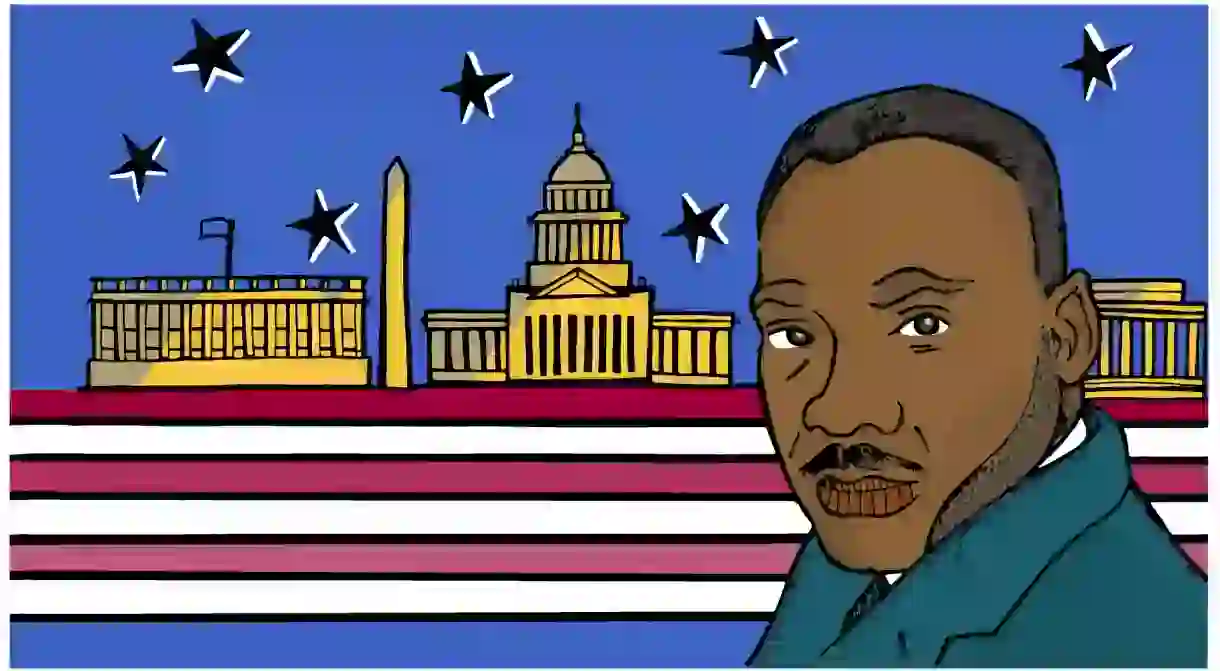Take a Hope-Inspiring Tour of Washington DC's Tributes to Dr Martin Luther King, Jr

Dr Martin Luther King Jr had a lasting effect on America’s future in Washington DC – from his famous “I Have a Dream” speech made on the National Mall, to the important work he did on Capitol Hill. Learn about the sites you can visit in Washington DC today that honor his legacy, and retrace his formative steps in the nation’s capital.

The Dr Martin Luther King, Jr Memorial and the bronze sculpture of Dr King in the Capitol Hill Rotunda are a must-see for visitors to Washington, DC. The monuments to Dr King are fitting titanic representations of a love, hope, democracy and justice champion, someone who will continue to affect the thoughts and actions of a substantial portion of the human race. One can picture Dr King’s stately and magnetic presence while delivering more than 2,500 speeches and traveling close to six million miles in the pursuit of freedom, equality and justice.
Conspicuous in the remarkable narrative that is Dr King’s life is Washington DC, which notably shows up 72 times in The Autobiography of Martin Luther King Jr. Dr King recognized Washington DC, which he spoke of in his famous “I Have a Dream” speech on the National Mall, as crucial to the work of hands-on emancipation of African Americans. He believed generating the much-needed legal restructuring would ‘‘make justice a reality for all.”

In 1964, at 35 years old, Dr King became the youngest Nobel Peace Prize Laureate. He received the topmost private citizen medals: the Presidential Medal of Freedom in 1977 and the Congressional Gold Medal in 2004. He was also part of the leadership of the foremost civil rights societies, the National Association for the Advancement of Colored People (NAACP) and the Southern Christian Leadership Conference. Dr King was a minister before expanding his repertoire to include human rights advocacy. He then developed into a scholar, writing five books and numerous articles. In 1994, President Bill Clinton signed into law the Martin Luther King, Jr Day of Service to prevail on all Americans to take part in volunteer work in Dr King’s honor on the third Monday in January.
August 28, 1963 is an unforgettable day among the many momentous ones in Dr King’s life. During the March on Washington for Jobs and Freedom, considered “the greatest demonstration for freedom in the history of our nation,” Dr King delivered his “I Have a Dream’’ speech. The crowd of approximately 250,000 people was aptly situated between testaments to two significant figures in the struggle for social equity, George Washington’s Monument and Abraham Lincoln’s Memorial.

Near the site of the speech, visitors can view many venerated cenotaphs, including the Franklin Delano Roosevelt Memorial, Korean War Veterans Memorial, Thomas Jefferson Memorial, Vietnam Veterans Memorial, National World War II Memorial, Jefferson Pier Marker and Peace Monument. All of these are within walking or driving distance of the Martin Luther King, Jr Memorial, the address of which is 1964 Independence Avenue, in honor of the 1964 Civil Rights Act that Dr King was instrumental in securing the passage of in Congress. The locations can be accessed for free by anyone seven days a week, 24 hours a day.
On August 22, 2011, the Martin Luther King, Jr Memorial was opened to the public. It is a four-acre wonderland that comprises a 30-foot (9m) figure of Dr King’s portrait engraved into the Stone of Hope, a 450-foot-long (137m) Inscription Wall showcasing 14 quotes from the works, discourses and homilies of Dr King. Inscribed in the Stone of Hope are the words, ‘‘Out of the mountain of despair, a stone of hope,” excerpted from Dr King’s “I Have a Dream” speech. Dr King is portrayed as looking toward the horizon to show his preoccupation not with the now, but the future.
Malcolm X and Dr King met only once in their lifetimes, in Washington, DC on Capitol Hill, where the Senate was hearing views on the Civil Rights Bill. After Dr King finished his address, Malcolm X approached him. The two civil rights icons exchanged less than 50 words and shook hands. Dr King later stated that the encounter had been too brief to allow for a proper conversation with regards to their divergent views on the means members of the Civil Rights Movement should adopt; Malcolm X promoted the use of aggressive methods, while Dr King favored pacifist approaches. They never met again.

Sightseeing at the Capitol affords visitors not only a chance to witness the spot of that historic meeting, but also an opportunity to view the Martin Luther King, Jr bust exhibited in the Capitol Rotunda since 1986. The figure, which has a 66in (168cm)-high Belgian black marble base with a 36in (91cm)-high sculpture of Dr King, was made by John Wilson. Wilson (1922-2015) was an African American artist who critiqued government policies and advocated for fairness using his masterpieces. The bust depicts Dr King’s head and shoulders, demonstrating a peaceful and pensive aura. Mrs Coretta Scott King, her four daughters and Dr King’s sister were all present when it was unveiled on January 16, 1986.
Dr King significantly altered America’s political, geographical, historical and legal landscape from Washington. We can only speculate how much stronger this connection would have grown had he not been assassinated in Memphis, Tennessee on April 4, 1968.













